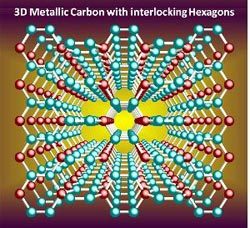Three-dimensional carbon goes metallic

Figure courtesy of Qian Wang, Ph.D.<br>
A theoretical, three-dimensional (3D) form of carbon that is metallic under ambient temperature and pressure has been discovered by an international research team.
The findings, which may significantly advance carbon science, are published online this week in the Early Edition of the Proceedings of the National Academy of Sciences.
Carbon science is a field of intense research. Not only does carbon form the chemical basis of life, but it has rich chemistry and physics, making it a target of interest to material scientists. From graphite to diamond to Buckminster fullerenes, nanotubes and graphene, carbon can display in a range of structures.
But the search for a stable three-dimensional form of carbon that is metallic under ambient conditions, including temperature and pressure, has remained an ongoing challenge for scientists in the field.
Researchers from Peking University, Virginia Commonwealth University and Shanghai Institute of Technical Physics employed state-of-the-art theoretical methods to show that it is possible to manipulate carbon to form a three-dimensional metallic phase with interlocking hexagons.
“The interlocking of hexagons provides two unique features – hexagonal arrangement introduces metallic character, and the interlocking form with tetrahedral bonding guarantees stability,” said co-lead investigator Puru Jena, Ph.D., distinguished professor of physics in the VCU College of Humanities and Sciences.
The right combination of these properties could one day be applied to a variety of technologies.
“Unlike high-pressure techniques that require three terapascals of pressure to make carbon metallic, the studied structures are stable at ambient conditions and may be synthesized using benzene or polyacenes molecules,” said co-lead investigator Qian Wang, Ph.D., who holds a professor position at Peking University and an adjunct faculty position at VCU.
“The new metallic carbon structures may have important applications in lightweight metals for space applications, catalysis and in devices showing negative differential resistance or superconductivity,” Wang said.
According to Jena, the team is still early in its discovery process, but hope that these findings may move the work from theory to the experimental phase.
The study is titled, “Three-dimensional Metallic Carbon: Stable Phases with Interlocking Hexagons.”
This research was supported by grants from the National Natural Science Foundation of China, grant numbers NSFC-11174014, NSFC-21273012; the National Grand Fundamental Research 973 Program of China, grant number 2012CB921404; and the U.S. Department of Energy, grant number DE-FG02-96ER45579.
EDITOR’S NOTE: A copy of the paper is available to reporters by contacting the PNAS News Office at (202).334.1310, or PNASnews@nas.edu.
About VCU and the VCU Medical Center
Virginia Commonwealth University is a major, urban public research university with national and international rankings in sponsored research. Located in downtown Richmond, VCU enrolls nearly 31,000 students in 223 degree and certificate programs in the arts, sciences and humanities. Sixty-eight of the programs are unique in Virginia, many of them crossing the disciplines of VCU’s 13 schools and one college. MCV Hospitals and the health sciences schools of Virginia Commonwealth University comprise the VCU Medical Center, one of the nation’s leading academic medical centers. For more, see www.vcu.edu.
Media Contact
More Information:
http://www.vcu.eduAll latest news from the category: Materials Sciences
Materials management deals with the research, development, manufacturing and processing of raw and industrial materials. Key aspects here are biological and medical issues, which play an increasingly important role in this field.
innovations-report offers in-depth articles related to the development and application of materials and the structure and properties of new materials.
Newest articles

Silicon Carbide Innovation Alliance to drive industrial-scale semiconductor work
Known for its ability to withstand extreme environments and high voltages, silicon carbide (SiC) is a semiconducting material made up of silicon and carbon atoms arranged into crystals that is…

New SPECT/CT technique shows impressive biomarker identification
…offers increased access for prostate cancer patients. A novel SPECT/CT acquisition method can accurately detect radiopharmaceutical biodistribution in a convenient manner for prostate cancer patients, opening the door for more…

How 3D printers can give robots a soft touch
Soft skin coverings and touch sensors have emerged as a promising feature for robots that are both safer and more intuitive for human interaction, but they are expensive and difficult…





















